Study on the Influence Mechanism and Space Distribution Characteristics of Rail Transit Station Area Accessibility Based on MGWR
Abstract
:1. Introduction
2. Study Area and Data Sources
2.1. Study Area
2.2. Data Sources
2.2.1. Rail Transit Station Location Data
2.2.2. Rail Transit Station Area Data
2.2.3. Data of Influencing Factors
3. Method
3.1. Research Framework
3.2. Evaluation of the Accessibility Distribution Characteristics of the Rail Transit Station Area
3.2.1. Acquisition and Accessibility Assessment of the Rail Transit Station Area
- Through the POI query service provided by Amap open platform, Python is used to obtain the location information of Beijing rail transit stations in batches, including the station name and specific coordinates, and the coordinate data are processed for easy research and use.
- A random generator is used to establish a dot array around each site with a radius of 1500 m, and the coordinates of all the points of the lattice are obtained.
- With the site as the starting point and each point in the dot matrix as the end point, the path time and walking action are planned through the Amap path planning service to obtain the return value.
- The points with a time of less than 900 s are screened, and the outermost points are connected into a polygon, that is, the 15 min walking range and the station domain accessibility of the site.
3.2.2. Cold–Hot Spot Analysis
3.2.3. Spatial Autocorrelation Analysis
3.3. Spatial Heterogeneity and Influencing Factors Analysis
3.3.1. Selection of Influencing Factors
3.3.2. Random Forest Regression Analysis
3.3.3. Correlation Analysis
3.3.4. Multi-Scale Geographic-Weighted Regression (MGWR)
4. Results and Discussion
4.1. Accessibility Results
4.2. Analysis of the Spatial Distribution Characteristics of the Rail Transit Station Area Accessibility
4.2.1. Analysis of the Rail Transit Station Area
4.2.2. The Spatial Clustering Characteristics of Beijing Rail Transit Station Area Accessibility
4.3. Analysis of the Influencing Factors
4.3.1. Accessibility Influencing Factors Mechanism Clustering Characteristics
4.3.2. Random Forest Regression Analysis of the Factors Influencing Accessibility
4.3.3. Correlation Analysis of Factors Influencing Accessibility
4.4. Interpretation of the Results from MGWR
4.4.1. Comparison of the Influence Mechanism Model
4.4.2. Results Analysis of the MGWR Model
4.5. Spatial Difference Analysis of Each Variable
- The functional mixing degree has the greatest impact on the accessibility of the rail transit station area with a positive impact, the higher the functional mixing degree of the rail transit station area, the higher the accessibility of the station area. In all rail transit stations, the influence of functional mixing degree on the accessibility of station area is relatively scattered. The positive relationship between this factor and station accessibility is mainly manifested in the station area between the East fourth Ring Road and the East fifth Ring Road, and between the West third Ring Road and the West fifth Ring Road. The influence of the functional mixing degree on the station heterogeneity between the fifth Ring Road and the sixth Ring Road also shows obvious spatial heterogeneity, and the accessibility of Beijing Subway line 6, Fangshan Line, and Daxing Line of Subway line 4 in the above two areas is more significant than that of other lines. The influence of the functional mixing degree inside the second ring on accessibility is lower than that outside the second Ring Road, which is due to the influence of policies in the second Ring Road and limited functional development, and the overall mixing degree is lower than that around the third Ring Road, so the influence is weak.
- The impact of the public service density on the station accessibility of rail transit stations has obvious spatial heterogeneity, and has a positive impact on the station accessibility; that is, the higher the public service density of rail transit stations, the higher the station accessibility. It shows a gradually significant influence from south to north; the influence of public service density is second only to the functional mixing degree. Spatially shows clear heterogeneity. The accessibility of rail transit stations located outside the North third Ring Road is higher than other stations affected by the density of public service. Among them, the public service density of Changping Line, the north section of Subway line 17, Subway line 15, and the end of Pinggu Line under construction have a strong positive impact on station accessibility. The influence of public service density on accessibility changes since the public service density itself shows a distinct hierarchical structure, and the central and southern parts are higher than the north, the impact of public service density on accessibility also shows this structure.
- The impact of the housing price on the station area accessibility has an obvious spatial heterogeneity; that is, the higher the housing price in the rail transit station area, the higher the accessibility in the station area. Stations with high housing prices indicate a higher level of development and better infrastructure, so accessibility is high.
- It has a positive impact on the station area accessibility. It shows a gradually significant trend of influence from west to east. The main affected stations are concentrated near the West sixth Ring Road, with the specific influence of Subway line 15, Subway line 6, Subway line 1/Batong Line and the eastern end of Pinggu Line under construction.
- The influence of residential centrality on station accessibility shows obvious spatial heterogeneity, and has a positive impact on station accessibility; that is, the closer the rail transit station is to the residential center, the higher the accessibility of the station is. It shows a gradually significant trend of influence from the southwest to northeast direction. Among them, it has the most significant impact on the northern terminal station area of Changping Line and the terminal station area of line 16.
- The influence of commercial centrality on the accessibility of the rail transit station shows obvious spatial heterogeneity, and has a positive impact on the station accessibility; that is, the closer the rail transit station is to the commercial center, the higher the station accessibility is. The overall performance is the trend of increasing influence from south to north, and the impact on the accessibility of the East fifth Ring Road and the North fifth Ring Road is higher than that in other regions. Among them, the accessibility of the northern terminal area of line 15, the northern terminal of Changping Line, and the station area of Pinggu Line is significantly affected by the commercial centrality.
- The influence of population density on the accessibility of station areas shows weak spatial heterogeneity and a negative influence on station accessibility; that is, the higher the population density within the range of rail transit stations, the lower the station accessibility. Population density has a significant impact on the accessibility of rail transit stations in the central region and the southwest region. The impact on the station area near and outside the sixth Ring Road is relatively low.
- The influence of the distance from the center on the station area accessibility shows the characteristics of polarization. The distance from the center has a positive impact on the accessibility of the station area outside the fifth Ring Road rail transit; that is, the farther the distance from the center, the higher the accessibility of the station area. However, the station domain accessibility has a negative impact on the station domain accessibility within the five rings; that is, the farther away from the center, the lower the station domain accessibility. The distance from the center has a significant impact on the accessibility of the external and central areas of the five rings. The level of development within the fifth ring road is relatively high, and the second ring road is the center to develop outward. The sub-center of the city and the Yizhuang Development Zone are located outside the fifth Ring Road, with a high level of infrastructure construction and high accessibility, so they are polarized.
- The influence of road density on the station accessibility overall shows a negative influence, with a positive influence on the accessibility of some stations near the sixth Ring Road of Fangshan Line and near the southeast corner of the fourth Ring Road. The station accessibility north of Chang’an Avenue and within the fourth Ring Road has a significant negative impact. This result is different from the finding that Dai et al. showed that road density is positively correlated with accessibility [28]. This is because this study considers the spatial heterogeneity of the influence of road density on accessibility.
5. Conclusions
- (1)
- The distribution of accessibility of the Beijing rail transit station area is unbalanced.
- Overall, there is high accessibility within the fourth ring, and low accessibility in areas outside the fourth ring. In the outer region of the fourth Ring Road, the accessibility of rail transit stations distributed in the north–south direction is higher than that of the east–west direction; that is, the accessibility of stations near the North fifth Ring Road and the South fifth Ring Road is higher than that near the East fifth Ring Road.
- The station area within the fourth Ring Road is a hot-spot area, while the station area between the East fifth Ring Road and the East sixth Ring Road is a cold-spot area. Therefore, it is considered that the accessibility construction of the outer station area of the East fifth Ring Road should be strengthened.
- (2)
- Multiple factors lead to uneven distribution of rail transit station accessibility.
- The factors influencing the accessibility of rail transit stations include road density, functional mixing degree, functional density, distance from the center, cultural and leisure density, public service density, population density, housing price, commercial centrality, and residential centrality. Population density, commercial centrality, and cultural leisure density have little influence on the accessibility of rail transit stations.
- Through the construction of the OLS regression model, GWR model, and MGWR model and comparison, the results show that the MGWR model has a higher degree of fitting with reality. Among them, the influence effects of five indicators are spatially heterogeneous, and in different geographical locations, the influence degree and direction on the accessibility of the station are different, and there are bidirectional effects. On the whole, there are five influencing factors of Beijing rail transit station accessibility with strong spatial heterogeneity.
Author Contributions
Funding
Conflicts of Interest
References
- Yin, M.; Tang, J.; Duan, J. The Synergy of High-speed Railway Station Areas and Urban Space Development. J. Urban Plan. Int. 2013, 28, 70–77. [Google Scholar]
- Fu, Y. Spatial Distribution Characteristics of Population in the Urban Fringe Area of Beijing under the Influence of Rail Transit. In Proceedings of the 2020/2021 China Urban Planning Annual Conference and 2021 China Urban Planning Academic Season, Chengdu, China, 25–30 September 2021; pp. 45–59. [Google Scholar]
- Monajem, S.; Nosratian, F.E. The evaluation of the spatial integration of station areas via the node place model; an application to subway station areas in Tehran. Transp. Res. Part D 2015, 40, 14–27. [Google Scholar] [CrossRef]
- Cai, C. Research on the Collaborative Development of Regional Accessibility and Spatial Distribution of Tianjin Rail Transit Station. Dr. Tianjin Univ. 2019, 43, 4–8. [Google Scholar]
- Hu, N.; Zhang, C. Impacts of Accessibility of Urban Rail Transit on Commuting Satisfaction. J. Urban Transp. China 2022, 20, 90–99. [Google Scholar] [CrossRef]
- Mao, J.; Yan, X. Study on the Relationship between Urban Land-use Pattern and Urban Transportation Pattern. J. Plan. 2002, 18, 69–72. [Google Scholar]
- Li, D.; Zang, H.; He, Q. Assessing Rail Station Accessibility Based on Improved Two-Step Floating Catchment Area Method and Map Service API. Sustainability 2022, 14, 15281. [Google Scholar] [CrossRef]
- Hansen, W.G. How Accessibility Shapes Land Use. J. Am. Plan. Assoc. 1959, 25, 73–76. [Google Scholar] [CrossRef]
- Cheng, C.; Zhang, W.; Chen, J.; Cai, J. Evaluating the Accessibility about Beijing’s Subways in 2008 Based on Spatial Syntax. J. Geo-Inf. Sci. 2007, 9, 31–35. [Google Scholar]
- Wei, P.; Huang, J.; Chen, Y.; Chen, N. Calculation Method of Urban Rail Transit Accessibility. J. Chongqing Jiaotong Univ. 2019, 38, 1–6. [Google Scholar]
- Yao, Z.; Fu, Y.; Zhang, J. Impacts of Accessibility to Transit Measures on Inequality Index of Public Transport. J. Transp. Syst. Eng. Inf. Technol. 2021, 21, 206. [Google Scholar]
- Ma, S.; Tang, D.; Li, X.; Sun, X. The accessibility of urban rail stations based on the catchment area. J. Shenzhen Univ. Sci. Eng. 2022, 39, 296–304. [Google Scholar] [CrossRef]
- Carra, M.; Ventura, P. HSR stations’ urban redevelopments as an impulse for pedestrian mobility. An evaluation model for a comparative perspective. In Pedestrians, Urban Spaces and Health; CRC Press: Boca Raton, FL, USA, 2020; pp. 120–124. [Google Scholar]
- Bertolini, L. Nodes and places: Complexities of railway station redevelopment. Eur. Plan. Stud. 1996, 4, 331–345. [Google Scholar] [CrossRef]
- Bertolini, L. Spatial Development Patterns and Public Transport: The Application of an Analytical Model in the Netherlands. Plan. Pract. Res. 1999, 14, 199–210. [Google Scholar] [CrossRef]
- Bowes, D.R.; Ihlanfeldt, K.R. Identifying the Impacts of Rail Transit Stations on Residential Property Values. J. Urban Econ. 2001, 50, 1–25. [Google Scholar] [CrossRef]
- Caset, F.; Vale, D.S.; Viana, C.M. Correction to: Measuring the Accessibility of Railway Stations in the Brussels Regional Express Network: A Node-Place Modeling Approach. Netw. Spat. Econ. 2018, 18, 495–530. [Google Scholar] [CrossRef]
- Vale, D.S. Transit-oriented development, integration of land use and transport, and pedestrian accessibility: Combining node-place model with pedestrian shed ratio to evaluate and classify station areas in Lisbon. J. Transp. Geogr. 2015, 45, 70–80. [Google Scholar] [CrossRef]
- Zuo, T.; Wei, H.; Chen, N. Promote transit via hardening first-and-last-mile accessibility: Learned from modeling commuters’ transit use. Transp. Res. Part D 2020, 86, 102446. [Google Scholar] [CrossRef]
- Zuo, T.; Wei, H.; Chen, N.; Zhang, C. First-and-last mile solution via bicycling to improving transit accessibility and advancing transportation equity. Cities 2020, 99, 102614. [Google Scholar] [CrossRef]
- Kusumo, C. Railway Station, Centres and Markets: Change and Stability in Patterns of Urban Centrality. Ph.D. Thesis, Delft University of Technology, Delft, The Netherlands, 2007. [Google Scholar]
- Carra, M.; Rossetti, S.; Tiboni, M.; Vetturi, D. Urban Regeneration Effects on Walkability Scenarios. An application of space-time assessment for the people-and-climate oriented perspective. TeMA-J. Land Use Mobil. Environ. 2022, 101–114. [Google Scholar] [CrossRef]
- Beijing Rail Transit Network Planning (2020–2035). Available online: http://yewu.ghzrzyw.beijing.gov.cn/zkdncmsUploadFile/gwzykfile/ueditor/20211209/1468822716583788546.pdf (accessed on 10 May 2022).
- Urban Master Plan of Beijing (2016–2035). Available online: http://ghzrzyw.beijing.gov.cn/zhengwuxinxi/zxzt/bjcsztgh20162035/202001/t20200102_1554612.html (accessed on 5 October 2022).
- Ren, J.; Wang, Y. Spatial accessibility of park green space in Huangpu District of Shanghai based on modified two-step floating catchment area method. J. Prog. Geogr. 2021, 40, 774–783. [Google Scholar] [CrossRef]
- Asif, R.; Muhammad, S.; Ming, Z.; Douglas, H.J. Analyzing Spatial Location Preference of Urban Activities with Mode-Dependent Accessibility Using Integrated Land Use–Transport Models. Land 2022, 11, 1139. [Google Scholar]
- Caselli, B.; Carra, M.; Rossetti, S.; Zazzi, M. From urban planning techniques to 15-minute neighbourhoods. A theoretical framework and GIS-based analysis of pedestrian accessibility to public services. Eur. Transp./Trasp. Eur. 2021, 1–15. [Google Scholar] [CrossRef]
- Dai, Z.; Jiang, J.; Mai, W.; Wang, X. Accessibility Quantitative Evaluation Method Based on Internet Map. Urban Mass Transit 2020, 23, 28–32. [Google Scholar] [CrossRef]
- Ord, J.K.; Getis, A. Local Spatial Autocorrelation Statistics: Distributional Issues and an Application. Geogr. Anal. 1995, 27, 286–306. [Google Scholar] [CrossRef]
- Jiawei, L.; Hou, K.; Wendong, T.; Hanyu, L.; Dan, H.; Lixia, M.; Haojie, T.; Siqi, W.; Kexin, Y.; Xuxiang, L. A spatial distribution—Principal component analysis (SD-PCA) model to assess pollution of heavy metals in soil. Sci. Total Environ. 2022, 859, 160112. [Google Scholar]
- Shi, J. Spatial Econometric Study on the Price of Second-hand Housing and its Influencing Factors in Beijing City. Master Tsinghua Univ. 2018, 56, 7–9. [Google Scholar]
- Guangsu, Z.; Xiaoyu, B. The effect of inequality of opportunity (IO) on housing accessibility: Evidence from China. Habitat Int. 2021, 116, 102414. [Google Scholar]
- Zhu, Y.A. Impact of Neighborhood Sociodemographic Characteristics on Food Store Accessibility in the United States Based on the 2020 US Census Data. Del. J. Public Health 2022, 8, 94. [Google Scholar] [CrossRef] [PubMed]
- Biau, G.; Scornet, E. A random forest guided tour. TEST 2016, 25, 197–227. [Google Scholar] [CrossRef] [Green Version]
- Linchuan, Y.; Yibin, A.; Jintao, K.; Yi, L.; Yuan, L. To walk or not to walk? Examining non-linear effects of streetscape greenery on walking propensity of older adults. J. Transp. Geogr. 2021, 94, 103099. [Google Scholar]
- Lu, B.; Ge, Y.; Qin, K.; Zheng, J. A Review on Geographically Weighted Regression. J. Geomat. Inf. Sci. Wuhan Univ. 2020, 45, 1356–1366. [Google Scholar] [CrossRef]



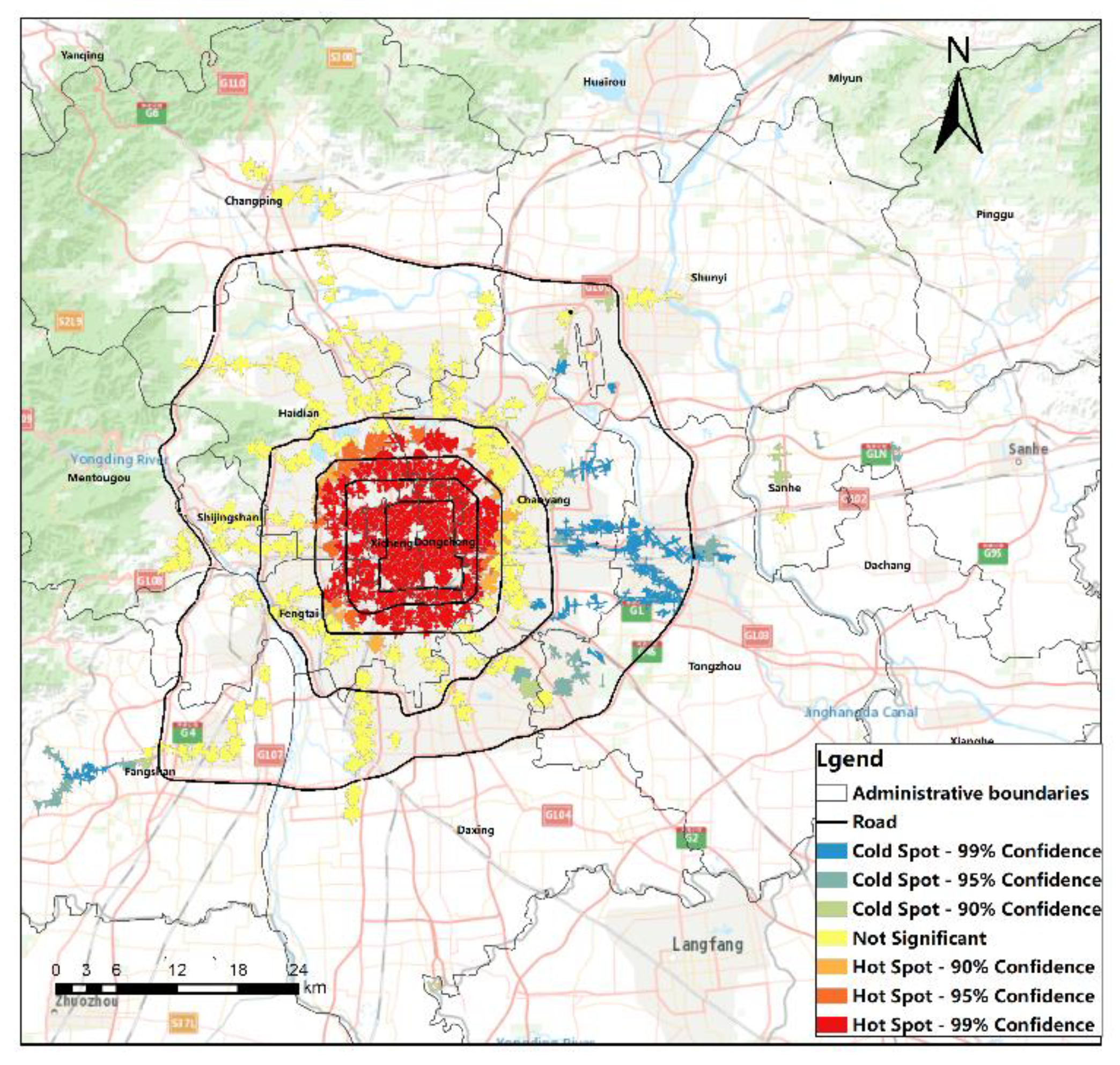
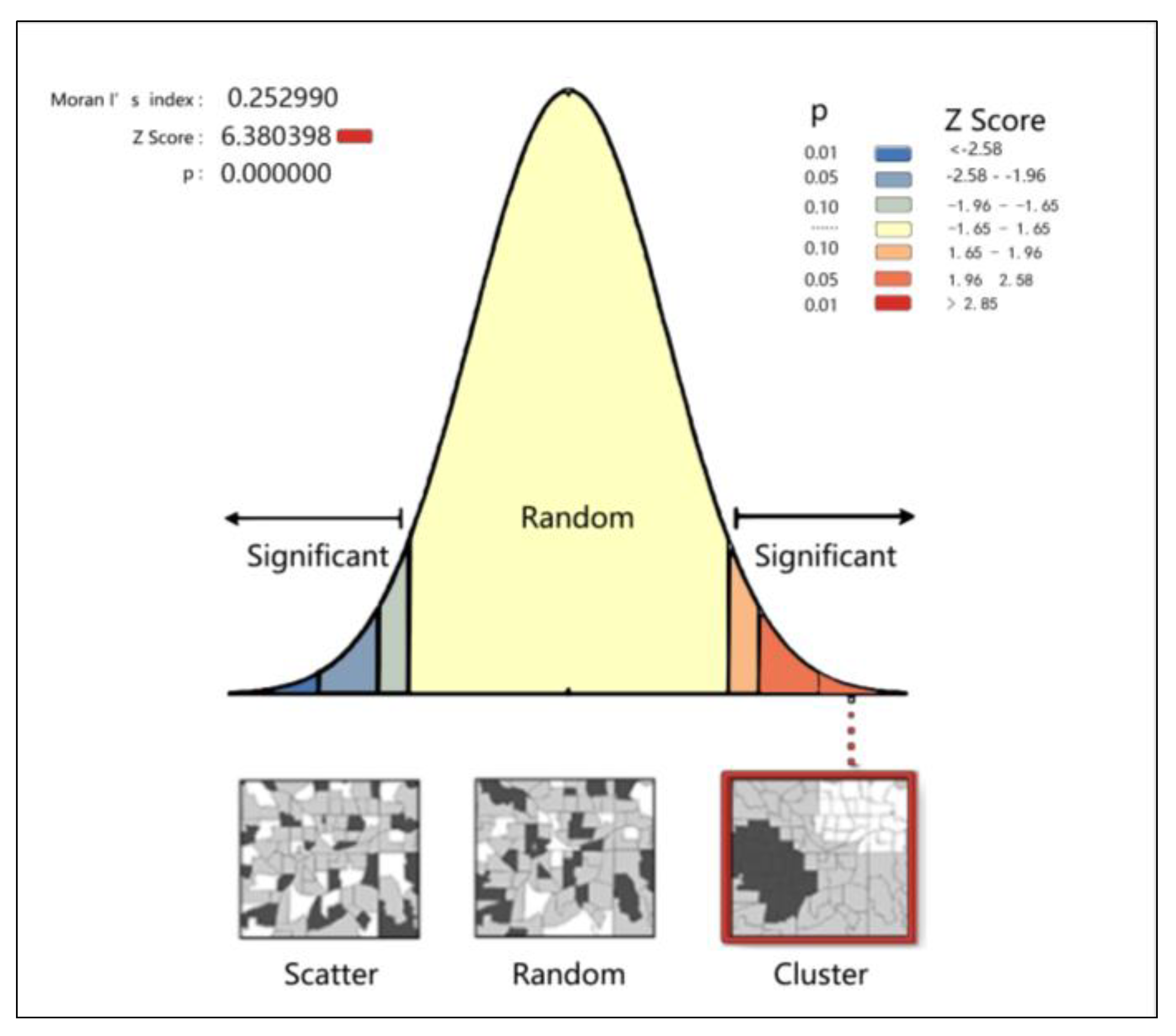

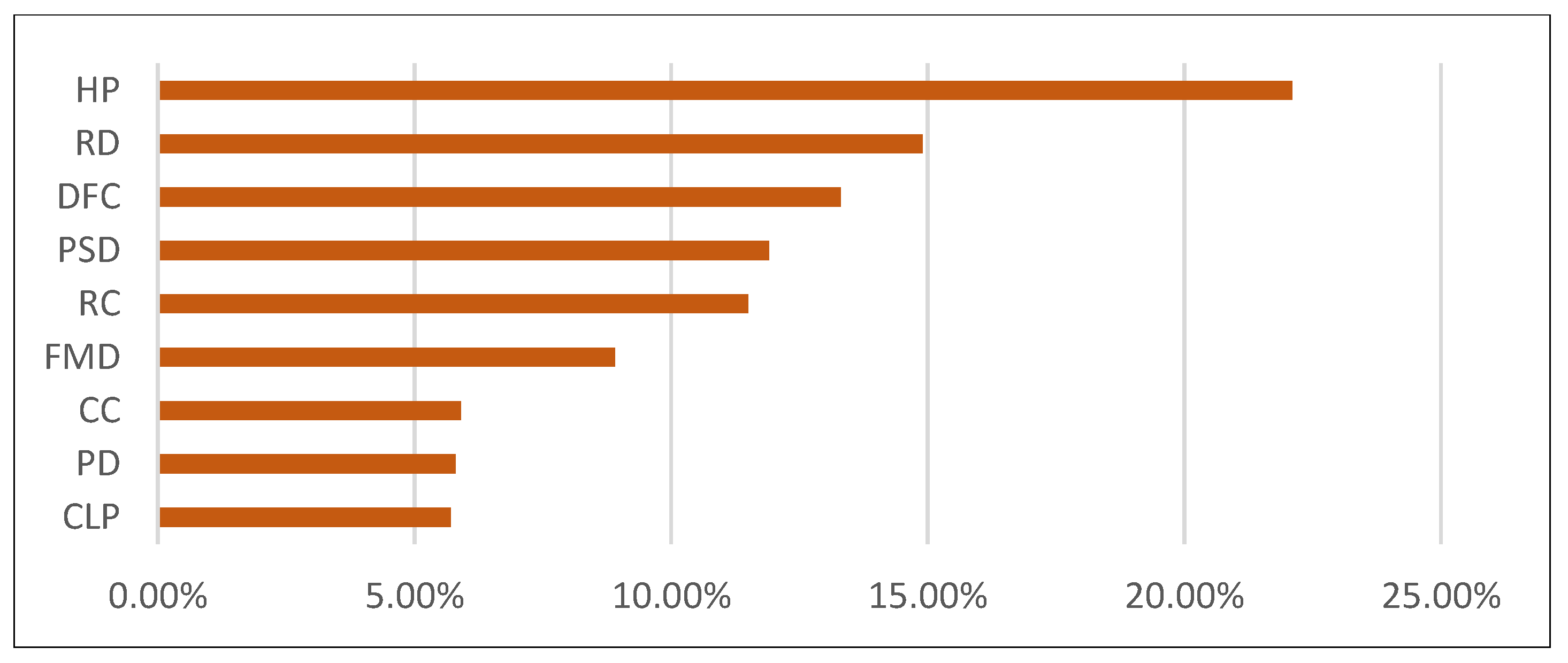

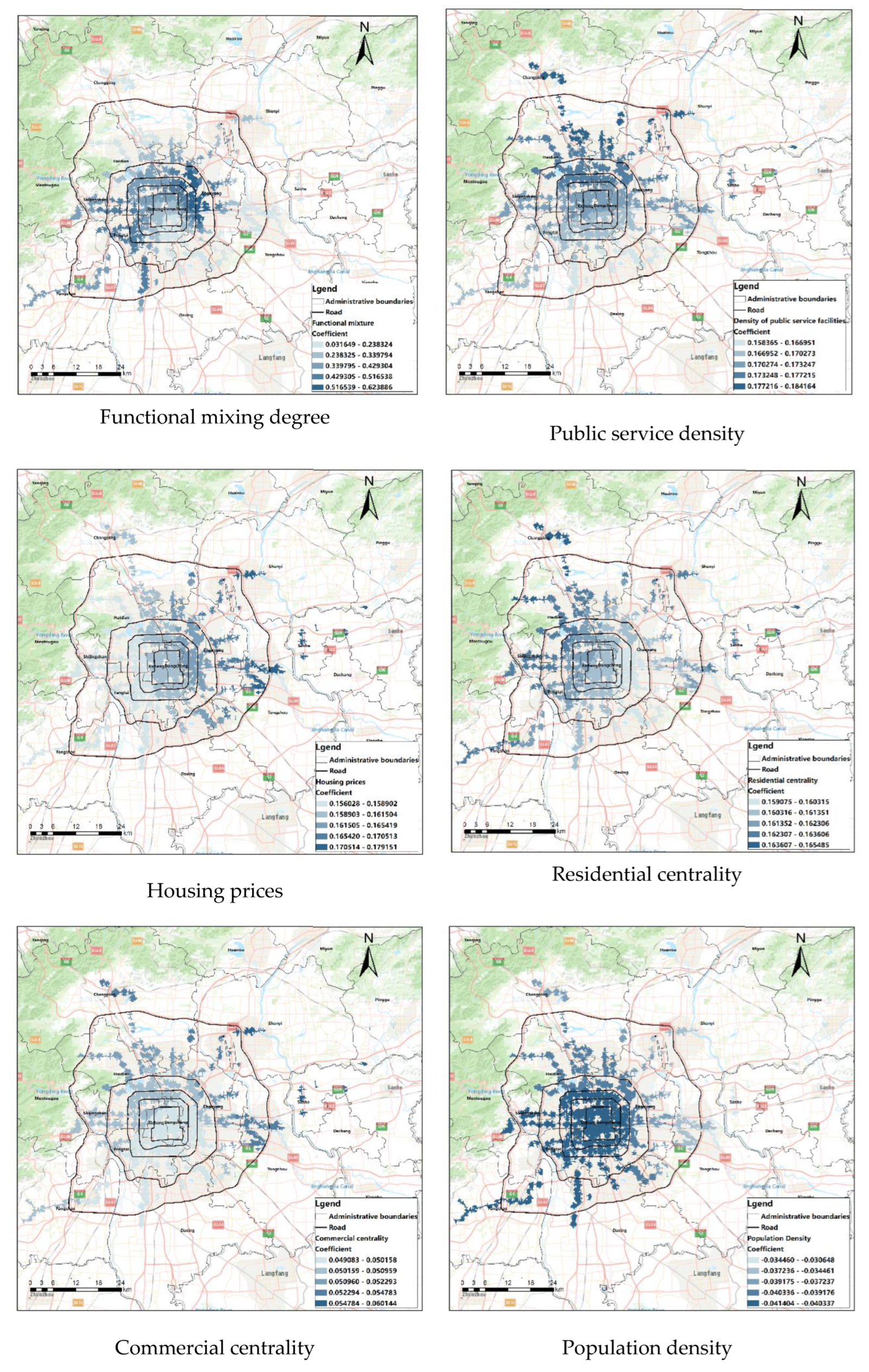
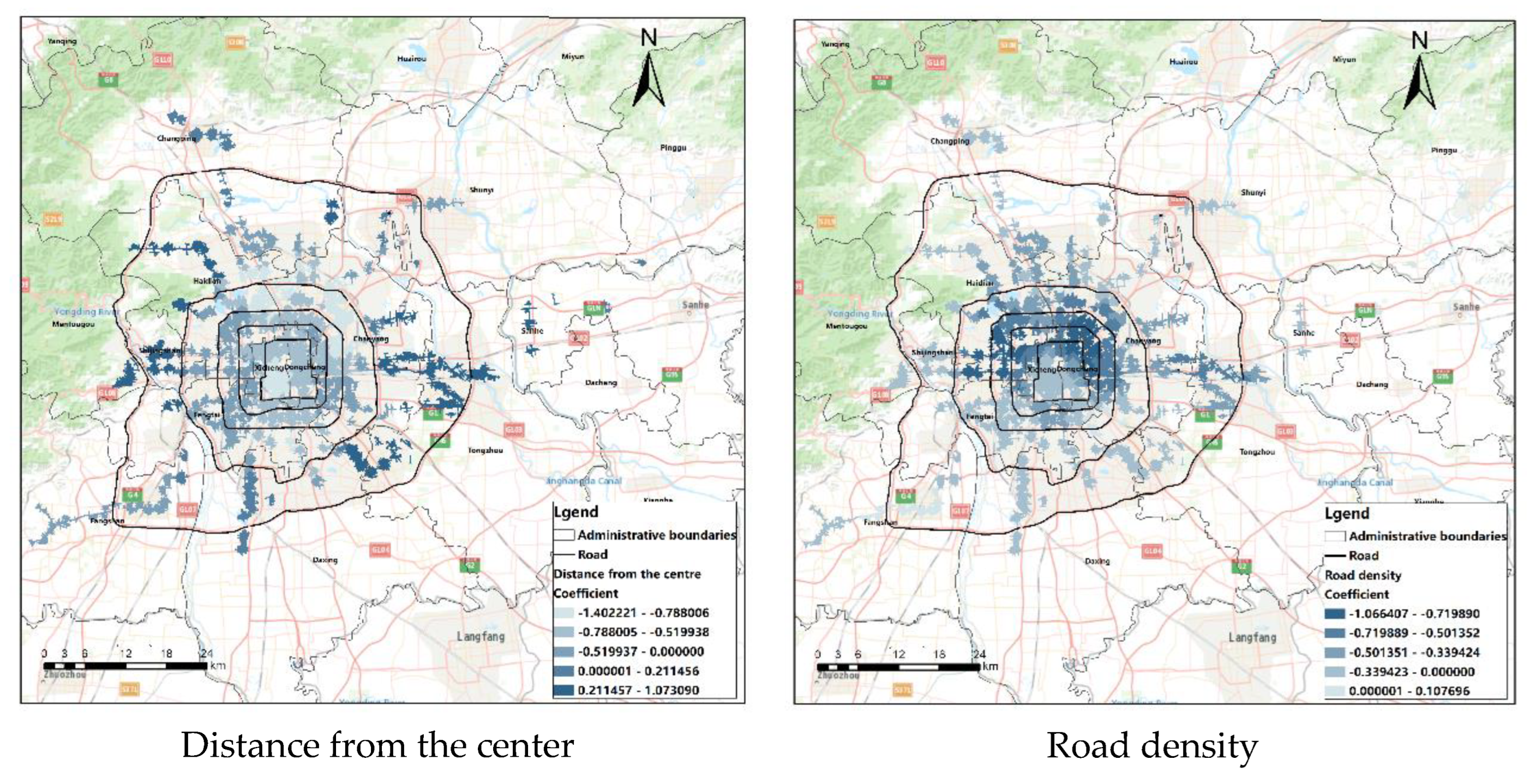
| Data Name | Obtained Time | Source | Formation |
|---|---|---|---|
| POI | July, 2022 | Amap Open platform | Excel |
| Administrative boundaries | June, 2022 | Aliyun Big Data platform | vector |
| Road network data | July, 2022 | Amap Open platform | vector |
| Population distribution at the 100 m resolution | July, 2022 | WorldPOP | grid |
| Housing estate price data | August, 2022 | Lianjia | Excel |
| Construction land | August, 2020 | GlobleLand30 | vector |
| Indicators | Calculation Method | Calculation Formula | |
|---|---|---|---|
| First-Level Indicators | Second-Level Indicators | ||
| Built environment | Road density (RD) | Ratio of road length to accessible area of each station area | Dri represents the road density of the i-th site area; Li represents the total road length of the i-th station area; Si represents the accessible area of the i-th site domain |
| Construction land proportion (CLP) | Ratio of construction land to accessible area of each station area | Di represents the construction land proportion of the i th site; Mi represents the construction area of the i th site; Si represents the accessible area of the i-th site domain | |
| Functional mixing degree (FMD) | Shannon diversity values for the POI types in each site area | H is the mixture of block functions, i is the number of POI categories within that block, pi is the ratio of the number of class i POI in the block to the total number of POI in the block | |
| Functional density (FD) | The ratio of POI quantity to accessible area | Di represents the POI function density of the i-th site domain; Pi represents the number of POI types in the i-th site domain; Si represents the accessible area of the i-th site domain | |
| Distance from the center (DFC) | The straight-line distance from each station to Tian’anmen Square | ||
| Cultural leisure density (CLD) | Cultural and leisure facilities include sports and leisure, scenic spots, shopping services, catering service POI, the calculation formula is the same function density | Same as functional density | |
| Public service density (PSD) | Public service facilities include government agencies and social organizations, science, education and cultural services, health care services, and the POI of public facilities. The calculation formula is the same as the functional density | Same as functional density | |
| Social environment | Population density (PD) | The ratio of population to accessible area in each station | Pi represents the population density of the i-th site; pi represents the total population in the i th station; Si represents the accessible area of the i-th site domain |
| Housing prices (HP) | Average housing price at each station area | Pi represents the i-th station area housing price; Si represents the sum of the average house price of each residential area in the i-th station; Ni represents the number of residential communities in the i-th site area | |
| Commercial centrality (CC) | Average nuclear density of commercial POI quantity, including shopping service, catering service, motorcycle service, car service, car maintenance, car sales POI | ||
| Residential centrality (RC) | Mean nuclear density of residential POI quantity, including business residential, residential service POI | ||
| First-Level Indicators | Built Environment | Social Environment | |||||||||
|---|---|---|---|---|---|---|---|---|---|---|---|
| Second-Level Indicators | RD | CLP | FMD | FD | DFC | CLD | PSD | PD | HP | CC | RC |
| Moran’s I index | 0.603446 | 0.261748 | 0.308113 | 0.630314 | 0.802362 | 0.481734 | 0.721675 | 0.460865 | 0.810325 | 0.508602 | 0.772155 |
| Z scores | 15.14644 | 6.616168 | 7.846358 | 15.83068 | 20.188620 | 12.140112 | 18.100903 | 11.571777 | 20.31261 | 12.821052 | 19.360691 |
| p value | 0.000 *** | 0.000 *** | 0.000 *** | 0.000 *** | 0.000 *** | 0.000 *** | 0.000 *** | 0.000 *** | 0.000 *** | 0.000 *** | 0.000 *** |
| Indicators | PD | DFC | RD | HP | FMD | RC | CLD | FD | CC | PSD | CLP |
|---|---|---|---|---|---|---|---|---|---|---|---|
| Beta | −0.107 | 0.003 | −0.197 | 00.363 | 0.136 | 0.197 | 0.093 | 0.019 | −0.036 | 0.092 | 0.104 |
| p value | 0.024 ** | 0.964 | 0.000 *** | 0.000 *** | 00.007 *** | 0.027 ** | 0.345 | 0.86 | 0.674 | 0.411 | 0.012 *** |
| VIF | 1.474 | 2.561 | 1.719 | 2.751 | 1.645 | 5.167 | 6.428 | 7.853 | 4.938 | 8.251 | 1.129 |
| Classification of the Correlation Results | Classification of the Random Forest Regression Results | |||
|---|---|---|---|---|
| Classification of positive and negative values | Promoting factors | Significantly promoting factors | General promoting factors | Weak promoting factors |
| Housing prices, road density | Public service density, functional mix degree, residential center | Population density, commercial centrality | ||
| Irrelevant factors | The proportion of construction land | |||
| Inhibiting factors | Significant inhibiting factor | General inhibiting factor | Weak inhibiting factor | |
| Distance from the center | ||||
| Model Name | OLS | GWR | MGWR | |
|---|---|---|---|---|
| AICc | 1049.035 | 1035.954 | 977.044 | |
| R2 | 0.381 | 0.507 | 0.721 | |
| Bandwidth | 128 | RD | 46 | |
| FMD | 135 | |||
| DFC | 43 | |||
| PSD | 425 | |||
| PD | 435 | |||
| HP | 425 | |||
| CC | 435 | |||
| RC | 435 | |||
| Influencing Factors | Average Value | Standard Deviation | Minimum | Median | Maximum |
|---|---|---|---|---|---|
| FMD | 0.349 | 0.12 | 0.032 | 0.373 | 0.624 |
| PSD | 0.172 | 0.004 | 0.158 | 0.172 | 0.184 |
| HP | 0.162 | 0.004 | 0.156 | 0.16 | 0.179 |
| RC | 0.162 | 0.001 | 0.159 | 0.161 | 0.165 |
| CC | 0.051 | 0.002 | 0.049 | 0.05 | 0.06 |
| PD | −0.04 | 0.002 | −0.041 | −0.04 | −0.031 |
| DFC | −0.315 | 0.45 | −1.402 | −0.433 | 1.073 |
| RD | −0.374 | 0.25 | −1.066 | −0.37 | 0.108 |
Disclaimer/Publisher’s Note: The statements, opinions and data contained in all publications are solely those of the individual author(s) and contributor(s) and not of MDPI and/or the editor(s). MDPI and/or the editor(s) disclaim responsibility for any injury to people or property resulting from any ideas, methods, instructions or products referred to in the content. |
© 2023 by the authors. Licensee MDPI, Basel, Switzerland. This article is an open access article distributed under the terms and conditions of the Creative Commons Attribution (CC BY) license (https://creativecommons.org/licenses/by/4.0/).
Share and Cite
Li, D.; Zang, H.; Yu, D.; He, Q.; Huang, X. Study on the Influence Mechanism and Space Distribution Characteristics of Rail Transit Station Area Accessibility Based on MGWR. Int. J. Environ. Res. Public Health 2023, 20, 1535. https://doi.org/10.3390/ijerph20021535
Li D, Zang H, Yu D, He Q, Huang X. Study on the Influence Mechanism and Space Distribution Characteristics of Rail Transit Station Area Accessibility Based on MGWR. International Journal of Environmental Research and Public Health. 2023; 20(2):1535. https://doi.org/10.3390/ijerph20021535
Chicago/Turabian StyleLi, Daoyong, Hengyi Zang, Demiao Yu, Qilin He, and Xiaoran Huang. 2023. "Study on the Influence Mechanism and Space Distribution Characteristics of Rail Transit Station Area Accessibility Based on MGWR" International Journal of Environmental Research and Public Health 20, no. 2: 1535. https://doi.org/10.3390/ijerph20021535
APA StyleLi, D., Zang, H., Yu, D., He, Q., & Huang, X. (2023). Study on the Influence Mechanism and Space Distribution Characteristics of Rail Transit Station Area Accessibility Based on MGWR. International Journal of Environmental Research and Public Health, 20(2), 1535. https://doi.org/10.3390/ijerph20021535







